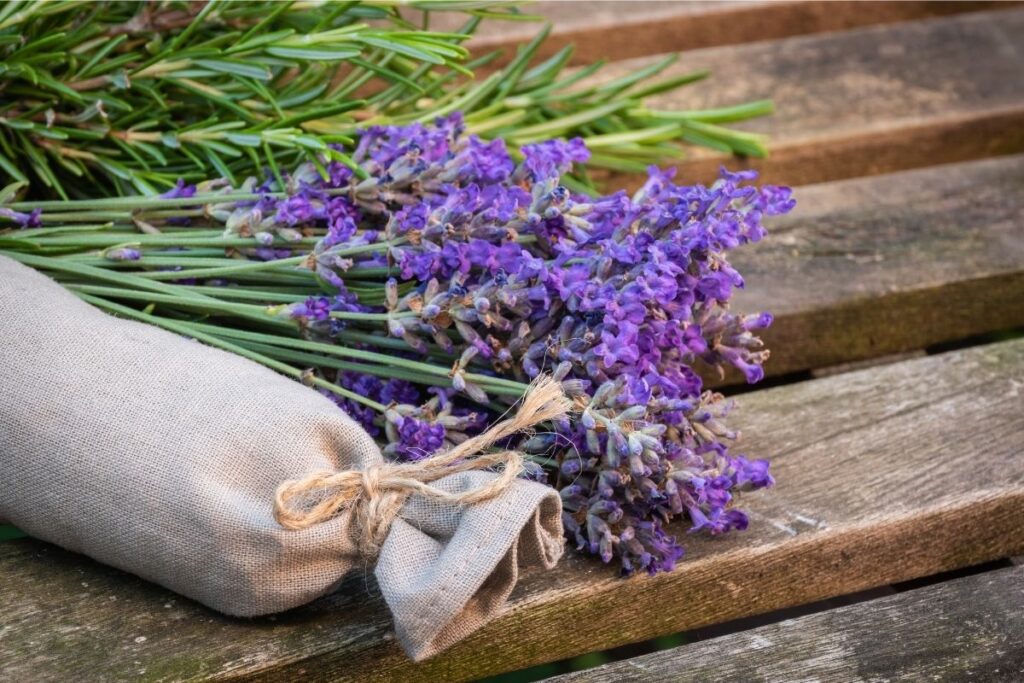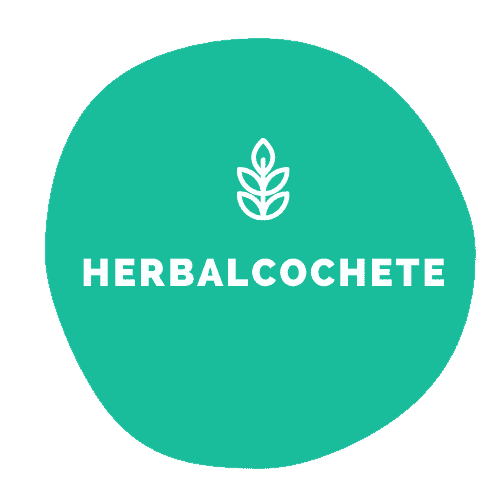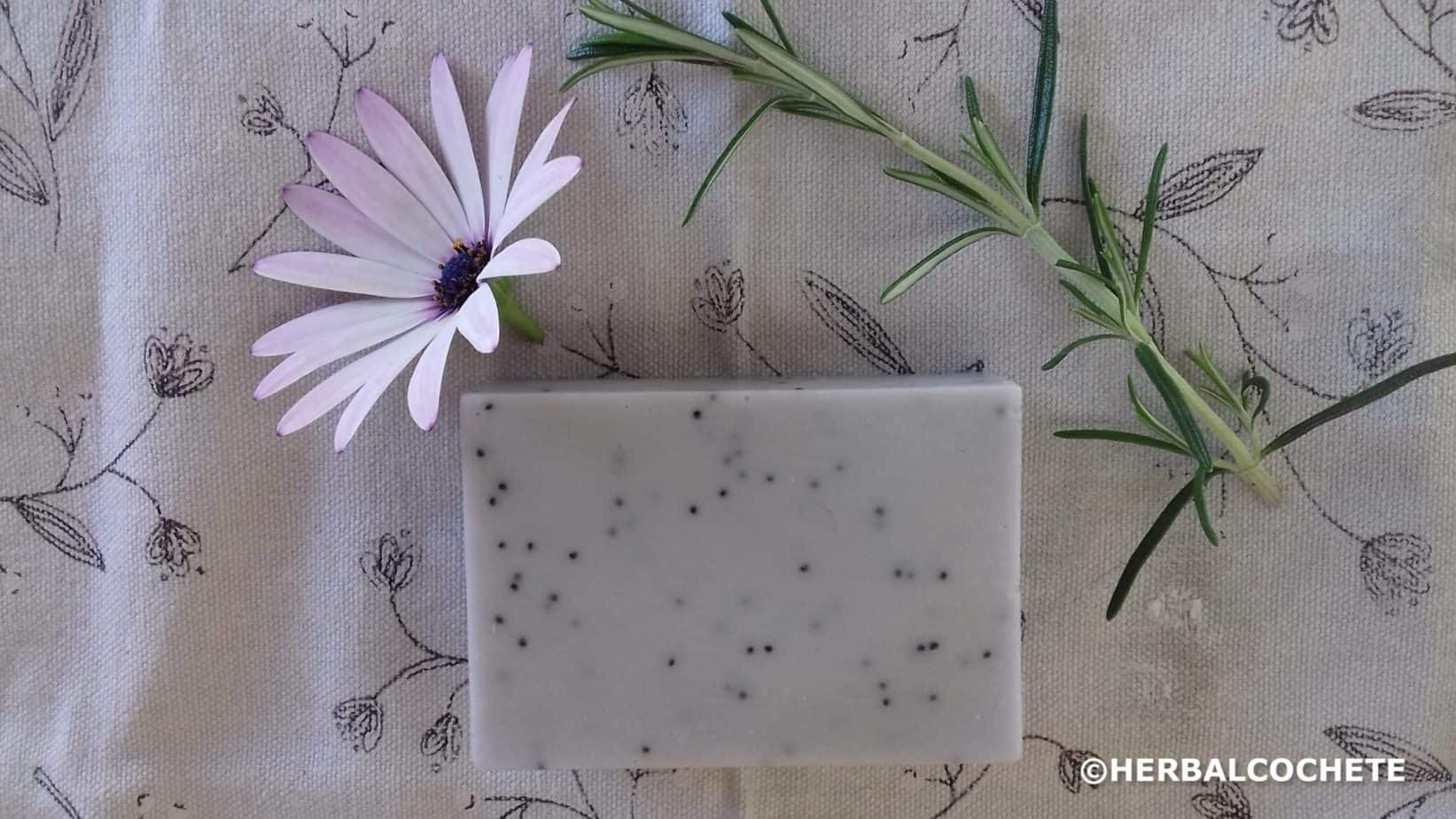A lovely rosemary and lavender soap recipe, for a very fragrant herbal soap with exfoliating properties. Rosemary and lavender, two of the most famous herbs in natural skincare, provide with the most natural and wonderful scents to this soap. Poppy seeds are added for moderate exfoliation.
Table of Contents
- Lavender and Rosemary
- Blemished Skin
- Rosemary and Lavender Soap Recipe
- Find Where To Buy Handmade Lavender and Rosemary Soap
- How To Use This Soap
- Related Posts
- Watch This Video About Safety
- Cold Process Soap Making Tutorial Video
- Cold Process Soap Making Lessons
Lavender and Rosemary
Lavender (Lavandula angustifolia) and rosemary (Rosmarinus officinalis) have been well introduced in two previous recipes: Layered Lavender Cold Process Soap Recipe and Homemade Rosemary and Eucalyptus Soap Recipe.
They are wonderful herbs, easy to grow in a small home garden. Lavender is also known to be relaxing, while rosemary is scientifically proven to treat and regenerate your hair. Check out Medicinal Plants For Skin And Hair Care.

Both help to lighten dark spots and blemishes on skin, resulting in an improved skin complexion. They are also good for treating acne. The anti-inflammatory properties of rosemary extract help to reduce swelling and puffiness of the skin. It also helps to heal burns and soothe the skin.
Lavender oil has antibacterial properties that helps to kill acne-inducing bacteria and clogged pores. By unclogging pores and reducing inflammation when you put it on your skin, lavender helps prevent acne from developing while treating existing blemishes.
If for nothing else, lavender and rosemary essential oils blend give a very fresh herbal scent to any soap.
Blemished Skin
Associated with a mild exfoliant like poppy seeds, this soap is perfect to cleanse blemished skin. A thoughtful regimen of appropriate skin care, healthful diet, and exercise can make a world of difference. If your skin problems are persistent, consult a dermatologist.
See Medicinal Plants Used in Cosmetics for more information on the lavender plant itself.
Rosemary and Lavender Soap Recipe
This recipe uses a mixture of oils to complement with the skin properties of lavender and rosemary. Olive oil turns any soap into a conditioning and very mild one. Coconut oil gives fluffy lather, while sunflower oil contributes for stabilizing the lather. Shea butter adds fatty acids and vitamins to tone, soften and soothe your skin, as well as add more anti-inflammatory properties.
Violet ultramarine mineral, considered a natural colorant, colors this soap. If you wish to turn this into a more natural soap, or are just afraid of colorants as skin irritants, you can skip it.
Find Where To Buy Handmade Lavender and Rosemary Soap
Still not inspired to make your own soap at home? But you do wish to use or give it a try at handmade soap with lavender and/or rosemary? You can find a few options online to buy handmade soap below:
- Apple Valley Rosemary Lavender Coconut Bar
- Lavender Coconut Oil Soap (Etsy)
- Lavender Lard Soap (Etsy)
- Rosemary Mint Soap (Etsy)
How To Use This Soap
In the shower or bath, wet your hands and rub your soap in them to create a lather. Wash your hands first, then repeat the process and apply soap to your whole body using the soap directly and your hands. You may also wash your face with it. Rinse hands and body abundantly. Also wash your soap from lather before placing it in your soap dish or bag saver.
Washcloths and sponges should be avoided. Avoid washing your intimate zone and your hair, soap pH in not adequate for those parts of your body. Avoid eye contact with soap to prevent stinging. Make a patch test before using your soap. Stop using your soap if you feel any immediate adverse reaction in your skin (red skin, rashes, itching).
To take best advantage of your handmade soap (made by yourself or store-bougth), read How Do You Use Handmade Soap?
Related Posts
Ingredients and Recipes
- Vegetable oils: Oil Properties For Soap Making
- Essential oils: Best Essential Oils for Soap Making
- Colorants: How To Color Your Soap With Kitchen Ingredients
- Beginner Recipes: Soap Recipes for Beginners
- Cold Process Soap Recipes: Free Cold Process Soap Recipes
Soap Making Techniques and Troubleshooting
- Cold Process Tutorial Guide: Learn To Make Cold Process Soap?
- Soap Making Methods: How To Make Soap At Home
- Soap Making Trace: Know Everything About Trace in Soap Making
- Soap Acceleration: Causes, How To Avoid It Or How To Fix It
- Soda Ash In Soap: What It Is, How to Remove It
Watch This Video About Safety
Cold Process Soap Making Tutorial Video
Cold Process Soap Making Lessons
The tutorials in this blog are a great – and free! – help to start with cold process soap making. Practice is the next step to harness the art of making soaps at home. However, I understand if you prefer to have some formal lessons, where you will feel more supported with the steps. Feel free to join these courses at Udemy.
Equipment
Ingredients
Lye Water
- 115 g distilled water
- 62 g lye (100% sodium hydroxide)
Oils
After Trace Ingredients
- 10 drops grapefruit seed extract (GSE) (anti-oxidant)
- ¼ tsp ultramarine violet (CI 77007)
- 1 ½ tsp poppy seeds to exfoliate
- 13 ml essential oils blend
- alcohol or witch hazel to sprinkle
Essential Oil Blend
- 1 tsp essential oil rosemary
- 1,5 tsp essential oil lavender
- 0,5 tsp essential oil cedarwood Atlas
Instructions
Get Ready!
- Wear goggles and gloves! Look at “Safety Precautions” in the video above or in Soap Making Safety Precautions
- Watch the video above about "Cold Process Soap Making Tutorial" or read the post Learn To Make Cold Process Soap for instructions on cold process soap making before starting. These are generic but important steps for all recipes.
- Assemble everything: ingredients, equipment, safety equipment. Prepare your workstations. Measure all the ingredients. Don’t start the recipe without having everything ready!
- Add the ultramarine colorant to one teaspoon of oil in a separate cup, mix well, and put aside. You can use the measured oil.
Heat the Oils
- Heat the oils until the solid oils are completely melted (it is not necessary to heat all the time).
Make the Lye Water
- Make the lye solution according to How To Make Lye Water. Mix it until the vapors start to dissipate.
Make the Soap Batter
- Use as a target temperature 40ºC for the oil-solution mixture. If necessary, you can reheat the oils, but not the lye solution.
- When adding the lye water to the oils, strain the water to avoid lye crystals in your soap batter.
- Add the oil with the colorant and mix well. Use the immersion blender to avoid clumps of colorant, but be careful not to reach heavy trace (creamy batter). If needed, use a whisker.
- Reach medium trace with the immersion blender.
- Add the rest of after trace ingredients: extract, essential oil (s) and poppy seeds. Stir with just a spoon. Lavender essential oil usually turns the soap batter from liquid to solid instantly. Be careful and be fast with the next step.
Molding and Curing
- Pour the dough into the large soap mold or silicone molds and sprinkle with alcohol or witch hazel.
- Optional step – Pre-heat the oven with 40ºC. Turn it off then place the molds inside: the color will be brighter if the molds are heat insulated.
- Wait 48 hours, keeping an eye on the hardness of the soap.
- Unmold and cut the soap into small bars (if you used the large soap mold). See How To Cure Soap, "Unmolding and Cutting" chapter.
- Let the bars cure for 4 to 6 weeks. See How To Cure Soap.




Good day Sofia Matias. Season greetings to you. Talking about the Lavender and Rosemary soap, these are two great herbs with distinct features and great fragrance. The fragrance and the exfoliating properties of this herbal soap that can be made at home make this a very fantastic herbal soap to give a try.
Hello Nelson, thanks for your comment and season greeting for you as well!!
Couldn’t agree more with what you say about this herbal soap.
Hope you give a try to the recipe!
Cheers,
Sofia
Hey there thank you sharing this article on rosemary and lavender soap, as a person that loves my skin a whol lot, articles like these always interest me and the article was also very educative. I have used a lavender soap before but I never knew that it had so much benefits as a natural herb, I’ll definitely get these soaps .
Hello Collinsss and thanks for your comment.
Actually I have done more research in the meantime and maybe lavender medicinal properties are a bit overstated in my article. Especially because it’s debatable if essential oil properties survive saponification. Maybe some of them remains, but there are not enough scientific studies to prove it. Still, it’s a natural plant with an amazing scent. Rosemary as well. Regardless if the medicinal properties stay on the soap or not, the scent is amazing 🙂
Cheers,
Sofia
Hello, great recipe of a lavender and rosemary soap. Loved the seeds, it makes the soap a mild exfoliant. Thanks for posting!
Thank you for this recipe, looking forward to making this soap with fresh rosemary from my garden in the next couple of weeks.
Question, why do you spritz with witch hazel or alcohol at the end? I’ve never done that with my soaps before, wondering what the benefit is.
Thanks!
Cheryl C
Hello Cheryl, you’ve placed a good question there.
Spritzing alcohol or witch hazel helps prevent soda ash. I use olive oil a lot in soap, being Portugal one of the few countries where olive oil is cheap 🙂 I get soda ash easily on my soaps, especially 100% olive oil. I have observed it happens more if you use a bigger percentage of liquid oils that hard oils (say 70% / 30% or higher). Of course if you never had it in your soap, or you like its appearance and never bothered hiding it, you don’t need to sprinkle anything.
Soda ash is a sort of a white powder (a bit like chalk) that forms at the surface of the soap. It’s sodium carbonate, a by product of lye reacting with the carbon dioxide in the air. It’s harmless, but it leaves your soap white 🙂 It’s annoying when you do pretty designs and they get hidden by soda ash.